Published: August 2nd 2016
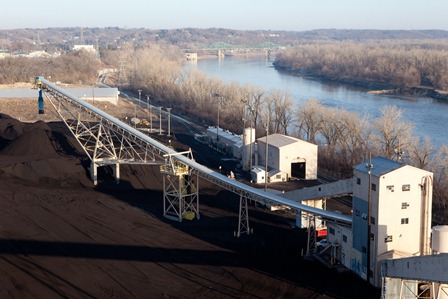
Recently, the Omaha Public Power District’s North Omaha Power Station was recognized as the Small Plant of the Year from the Powder River Basin (PRB) Coal Users’ Group, for its innovation and implementation of industry best practices. Congratulations OPPD!
The Omaha Public Power District (OPPD) employs 2,300 people and operates over 15,500 miles of electric transmission and distribution lines in Nebraska. OPPD is one of the largest publicly owned electric utilities in the United States, serving more than 350,000 customers in 13 southeast Nebraska counties. Organized as a political subdivision of the State of Nebraska in 1946, today OPPD has a generating capacity of over 3,200 Megawatts, almost half of which is generated from coal. OPPD does have fuel diversity with other generation from nuclear, natural gas, wind and landfill gas.
In the 1980s, OPPD was converted to burn cleaner, lower sulfur coal from Wyoming’s Powder River Basin (PRB), as part of their commitment to best environmental stewardship practices. The North Omaha Power Station, a 646 Megawatt coal fired power plant located on the Missouri River north of the city, was constructed over 50 years ago and the five-unit plant was initially designed to burn Midwestern high sulfur coal. Though now cleaner, during the initial conversion process, the plant was not fully optimized to address the particular dust mitigation techniques necessary when handling PRB coal.
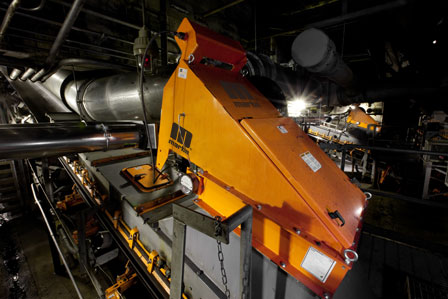
While containing less sulfur, PRB coal contains more water, generates less heat and burns less efficiently than the type of coal it replaced. In fact, though overall emissions have been reduced, the plant now requires more through-put to ensure the same generating capacity. Even more vexing, due to several of the inherent properties of PRB coal, it is prone to sudden, spontaneous combustion (spon-com). Controlling spon-com is both time consuming and frustrating. One could perfectly control the coal’s temperature, prevent sparks and flames from hitting it and it could still just start burning on its own. On top of that, the coal easily breaks down into tiny highly flammable dust particles that, if left untreated, can float in the air and potentially ignite.
Adjusting material handling flow to the characteristics of PRB coal and addressing its unique safety hazards led OPPD to seek Martin Engineering’s expertise. Several years ago management at OPPD started taking steps to prepare the plant to become a leader in PRB safety handling. OPPD took these steps because they knew better coal handling ensures a more productive plant, safer and healthier employees and more consistent production.
“Our plant puts an extremely high value on safety. We have 120 employees here, and our recordable injury frequency rate is extremely low. It is imperative that our employees work safely, and it’s everyone’s job to ensure a healthy and safe environment to work within. That way everybody wins. OPPD and Martin have worked very well together in a dust mitigation and safety partnership,” said Kirk Estee, P.E. Material Handling Supervisor at OPPD.
OPPD was using a conventional, dated materials handling system. Martin was asked to conduct a safety and materials handling audit specifically addressing fugitive dust and overall coal dust control. This audit revealed some opportunities to upgrade conveyors that would maximize safety, while also addressing the coal dust concerns.
After walking down the belts and conveyors, reviewing the chutes and other coal handling facilities, Martin employees immediately began to take note of how and where they could make a large difference to the overall safety of the plant. “Chute design has changed considerable since their system was first installed,” observed Martin Engineering Territory Manager Jim Densberger. “Today’s transfer chutes employ special geometries that capture and concentrate the material stream as it travels through the chute.
“Every design is tailored to suit the specific material characteristics and conveyor systems of the individual customer, rather than using stock products and attempting to make them work,” he explained. Transfer Chutes from Martin provide the dual benefits of minimizing aeration and preventing buildup within the chute, particularly important when dealing with combustible materials.
Working together, OPPD and Martin developed a multi-year improvement plan to ensure a safer dust environment. OPPD initiated a multi-phase project aimed at combustible dust mediation. As management requested proposals on the first scoped project, they determined that whichever vendor was awarded the first project, that equipment would be standardized. OPPD did not want to have three to four different vendors stocking similar materials and confusing employees.
“Martin has been very responsive from an RFP standpoint. Throughout our on-going relationship, they’ve been very responsive the whole way, giving us competitive pricing, standing behind their product and ensuring that they operate reliably,” said Estee.
The project started with the first installation beginning in Oct. 2009 and completed over four phases, finishing in 2012 and included transfer point upgrades to twelve belts throughout the plant and installation of insertable air cleaners to 12 load zones.
Martin Engineering supplied components to contain material and improve serviceability. Belt support cradles were installed under the drop chutes to absorb impact and stabilize the belt lines and prevent spillage. Martin® Wear Liners were mounted on the load zone’s existing skirtboard for improved sealing.
Martin then installed Martin® insertable Air Cleaners on the load zones to further reduce the escape of fugitive material. Rather than carry dust-laden air to a central collector, insertable systems filter the air inside the transfer point where they can easily return the material to the conveying system.
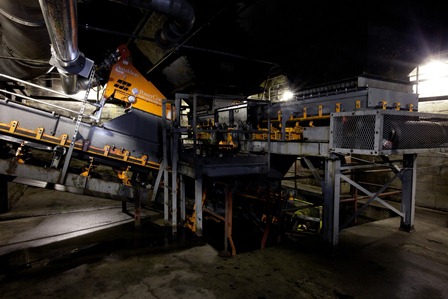
The air cleaners use an internal fan to pull dust-laden air through the filter elements. The air passes through the filter, leaving the particles on the filter element. The filters are a pleated fiber design, which essentially creates flutes. Each filter contains multiple flutes that are arranged in such a way, that any dust laden air that is pulled into the cleaner must travel through one of the flutes. When the air reaches the end of the flute, it must pass through the flute, leaving the dust behind. As material is captured by the filters, it agglomerates with other dust particles against the filter media.
Each filter element is then cleaned by a reverse jet of compressed air. This causes a momentary reversal of the air flow dis-loading the agglomerated dust back into the main material body. The air cleaners have a minimum of two filter elements and the pulse is staggered to allow at least one filter to be operating at full capacity while the other is being cleaned. If a pulsed particle is too small to drop out of the air stream, it is immediately pulled into an active filter. This alternating pulsing eliminates the potential for a pulse to create a momentary plume of airborne dust.
The filter material is also impregnated with carbon fibers to dissipate any buildup static electricity. This weave of carbon fibers allow any built-up charge to be instantly grounded out of the filters. The carbon impregnation allows the filters to have a total resistance of less than 108 ohms, tested per ESD STM 11.11-2001. As a charge cannot be built up on the filter elements, no spark is possible. This no spark filter, combined with other intrinsically safe construction, allow any potentially spark generating charge to ground out of the system almost instantaneously. “The end result is an air cleaner that can safely exist in an explosion hazardous environment,” said Martin Engineering Territory Manager Jim Densberger.
The components of a central “baghouse” dust collection system are: the collector, the blower, the disposal system, the ducting and the isolation valve. Each of these components has problems associated with them. Installation of insertable air cleaners eliminates many of the problems seen with central collection systems.
Once the dust is collected, it must be transported and redeposited into the material stream. The secondary handling of a fine, explosive material creates safety and logistical challenges in itself.
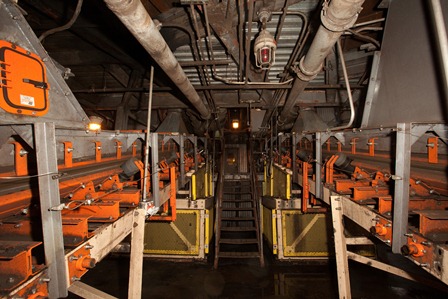
The duct used to connect the collector to the pickup point must be sized to prevent any dust from settling out of the airstream. This is a straightforward process, unless there are multiple pickup points. The flow in each section of the duct must be analyzed and sized so the velocity in every branch of the system maintains high velocity. Pressure losses are proportional to velocity, so a large velocity will cause a large pressure drop. These ducts are susceptible to dust settling out of the stream if the flow is altered. This alteration can come in the form of the flows being altered by worker or the failure of a duct. This failure will not only release dust into the environment, but it will change the balance of the system. If dust is accumulated in the duct, due to design error or alterations, and the material ignites, or self-ignites, there is potential for fire in the duct system.
Because a collector is considered an enclosed apparatus, it must be protected from flames traveling to the collector though the ducts. The method used to stop flames, if present, is an isolation valve. This is a valve that senses an increase in pressure or temperature, and closes the duct if one of these conditions is detected. This is required for any central collection system.
Individual branches of the collection system cannot be isolated, as a change in flow in one branch will impact the other parts of the system. Because of this, an individual pickup point cannot be maintained without either shutting off the system or impacting the effectiveness of other branches.
On the other hand, insertable filters are integrated into the transfer point enclosure, where they can easily return material to the conveying system. The insertable filters also eliminate the problematic components of a central system, thereby eliminating many of the problems associated with the systems.
The integrated air cleaner filter housing is an apparatus designed to support the filter elements, while allowing dirty air to enter the filter and clean air to exit. The integrated air cleaning system utilizes a series of independently operating assemblies at each dust generation point. The loss of a single unit to maintenance will not result in an operation wide shutdown of the dust collection system. This decentralized arrangement allows cleaners to be put into a maintenance cycle and each unit can be maintained at a time other than a plant wide outage.
The very nature of the design of the integrated air cleaner eliminates many of the disadvantages of a central dust collector while providing the same level of filtration.
Additionally, Martin installed a Dust Fighter™ Foam system to further reduce fugitive dust. The foam system mixes and applies consistent dust suppression foam to the load to control airborne dust while minimizing the addition of moisture to the material. The foam system consists of a cylinder with inlets for the lines carrying air and the chemical/water mixture and outlets to accommodate up to 8 nozzles. Duckbill nozzles are set in a cam mechanism that allows the nozzle to be removed from the chute for maintenance without requiring any tools.
The system architecture allows the system to be easily automated by including electrical ball valves in the water line at the inlet of the pump module and at the air inlet of the foaming chamber.
The new Martin dust collectors have allowed the North Omaha Station to become safer “because now that we can use the smaller Martin products, we can shut down the older, larger dust collector that has a history of explosion hazards. The little ones don’t contain, capture or store large amounts of fuel. They just have a few ounces of coal in them at any time, and they’re always purging and cleaning themselves. From a safety standpoint, that’s why they’re great,” said Estee.
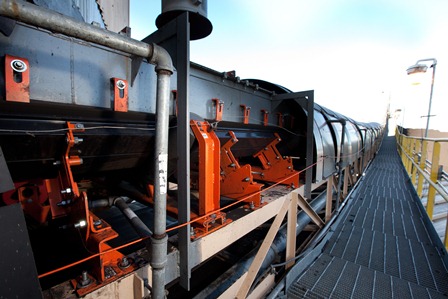
The new insertable air cleaners are only one part in a larger dust mitigation strategy that includes dust containment and other fundamental practices that Martin advocates. “The air cleaners are icing on the cake. The insertables are a safer way to do the dust collection. But maintaining and understanding Martin’s dust control foundations is the most important change we’ve made on this front,” said Estee.
Overall, the biggest dust control improvement has been the rebuilding of the coal transfer points to contain that dust. “We used to have lots of dust and spillage. But now that all the transfer points have been rebuilt, it’s a night and day difference. The majority of the continued spillage is due to other operational problems that are being addressed,” said Estee.
To help ensure that all the transfer points are working properly, Martin Service Technicians come to the plant monthly, walks through the belt lines and transfer points. Technicians replace the various wear items, adjust the belt cleaners and ensure that proper tension levels throughout the coal handling conveyor system are maintained. Martin also keeps a parts inventory on site that they withdraw from as needed. If a new seal, belt cleaner or other item is needed, it is close at hand.
Given Martin’s history and longevity, OPPD management knows they can trust Martin for the long haul. “When Martin’s personnel go through every month, they’re going through looking at their own equipment that they installed. Because they are familiar with our system, they’re able to quickly and efficiently diagnose problems as they arise,” said Estee.
“They come in, install product for you, and return not only to ensure that the system is working properly, but they take it upon themselves to look for problems. Because we don’t always have the time to study all the inherent challenges posed by dust control, Martin makes sure that everything is working as promised,” said Estee.